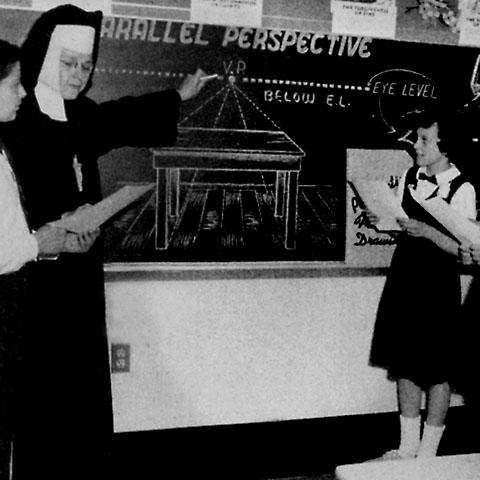 American Catholicism was defined by waves of immigration: older populations in Maryland and the Southwest were joined in the 19th and 20th centuries by immigrants from Europe and Latin America. Tensions between various nationalities, in addition to a dialectic between assimilation and the preservation of devotional practices, defined 20th century Catholic life. The 20th century also saw the election of the first Catholic president of the United States.
American Catholicism was defined by waves of immigration: older populations in Maryland and the Southwest were joined in the 19th and 20th centuries by immigrants from Europe and Latin America. Tensions between various nationalities, in addition to a dialectic between assimilation and the preservation of devotional practices, defined 20th century Catholic life. The 20th century also saw the election of the first Catholic president of the United States.
View full album
Immigration transformed American Catholicism from a small church dominated by Maryland gentry at the opening of the national period into the largest single denomination in the United States by the time of the Civil War. Raw statistics tell one part of the story. Between 1820 and 1920, the American Catholic population rose dramatically, with 4,300,000 Irish Catholics by 1850 and 1,650,000 German Catholics by 1880. Approximately four million Italians arrived between 1880 and 1920, two million Poles between 1870 and 1920, and one million French Canadians between 1880 and 1910. Slovaks, Czechs, Lithuanians, and other immigrants, as well as the Spanish Catholics of the old Southwest expanded this diversity even further. Moreover, many Eastern rite Catholics also began to immigrate to the United States in the 1870s, particularly Ukrainian and Carpathian Greek Catholics, who were recruited to work in the mills and mines of the Northeast.
More recently, Catholics immigration from Europe has slowed, while Hispanics, with their diverse and rich expressions of Catholic faith, have become a source of vitality in the U.S. Church. Since 1960, Hispanics have accounted for 71% of the growth of the Catholic population in the United States, largely due to sustained migration patterns from Latin America and the Spanish-speaking Caribbean. As a result, Hispanic Catholics, who have been present in the U.S. longer than any other Catholic group, are moving from the periphery to the center of the Church. As of 2015, over a quarter of all Catholic parishes in the U.S. offered services in Spanish. Hispanic Catholics continue to play a role in the ongoing evolution of U.S. Catholic parishes from ethnic enclaves to multicultural congregations. New waves of immigration continues to transform American Catholicism into a multi-national, multi-ethnic church in which dozens of languages are spoken and countless devotional traditions have flourished With the influx of new immigrants, leaders of the American Catholic Church felt it necessary to devise a strategy to combat deep-seated anti-Catholic sentiment. Protestant hostility to Catholics was as old as the first English settlements in North America, and nativist movements in the nineteenth century continued to stoke these prejudices. Some of the nation’s most influential Protestant clergy warned that “Romanism” threatened American liberties and morals. Occasionally, violent mobs took shape, one of which infamously burned down an Ursuline convent in Charlestown, Massachusetts.The Church’s predominantly Irish leadership believed it necessary to Americanize immigrants in order to integrate them into the nation’s dominant culture. At the same time, they worried that too much assimilation might undermine central Catholic sacramental traditions, doctrines, and practices, such as devotion to the saints and Mary. With the encouragement of the Vatican, Catholic leaders adopted a “fortress church” strategy designed to unite immigrants from many nations in a single American Catholic church, while also shielding them from Protestant influence. A keystone to this strategy was the creation of an extensive Catholic educational system, including thousands of parochial schools that flourished for over a century, well into the 1960s. Among those involved in the beginnings of the Catholic parochial school movement was Elizabeth Seton (1774-1821), founder of a teaching order called the Sisters of Charity. Seton was the first American-born Catholic saint, canonized by Pope Paul VI in 1975.
American Catholics have experienced perennial tension between the progressive climate of America and the more traditional leadership of Rome. One outstanding example of this tension occurred in the second half of the 19th century when Archbishop John Ireland of St. Paul, Minnesota, and other bishops steered American Catholicism in a theologically and socially progressive direction. The papacy affirmed many of Archbishop Ireland’s social ideals but, at the same time, quashed liberal theological developments. As a result, many American Catholics entered the 20th century as social progressives and theological conservatives. A similar development occurred after the Second Vatican Council convened in the 1960s. The statements and actions of the Council under Pope John XXIII encouraged many Catholics, both clergy and laity, who expected radical changes in theology, the role of women in the church, and a range of other issues However, their enthusiasm dampened over the course of several decades by the more conservative papacy of John’s successors.
In 1960, America also saw the election of its first Catholic president, John F. Kennedy. This was a significant milestone for American Catholics. From this point on, Roman Catholic identity would no longer be an obstacle to high political office, evidenced by the 2020 election of President Joe Biden, also a practicing Catholic.
According to the Association of Religion Data Archives, Catholicism remains the largest single American denomination. Nevertheless, American Catholicism today faces many new challenges: a sharp decline in clergy; the erosion of once tightly-knit ethnic communities; ministering to the needs of new immigrant communities; the scandal of widespread sexual abuse of young people by clergy and its cover-up by bishops; and heightening tensions within the Church over teachings including the ordination of women, contraception, abortion, and LGBTQ+ rights. Still, Catholicism in America is nonetheless vital and dynamic, inflected by the many different cultural traditions, practices, and social perspectives which comprise its body.